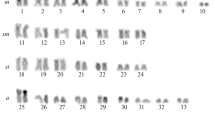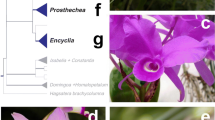Abstract
The genus Salvia is characterized by such small chromosomes, which has so far restricted the cytogenetic studies. Therefore, karyomorphological aspects of the chromosome complement were rarely analyzed in the genus. The aim of this study was to report the interspecific relationships and new chromosomal data in Salvia. The chromosomal records of 25 taxa were herein provided, 8 of which were reported for the first time, 3 presented new chromosome numbers, and 14 agreed previous reports. In addition, a detailed chromosomal data of 16 taxa were provided. Eleven different chromosome numbers (2n = 12, 14, 16, 18, 22, 26, 28, 36, 38, 42, and 52) were found by the basic number of 6, 7, 8, 9, 11, and 13. S. candelabrum was the only taxon with B-chromosomes. Salvia algeriensis had different chromosome numbers with probably dysploidy mechanisms. The polyploidy was demonstrated by the prevalence of cells with 2n = 4x = 28, 36, and 52 (tetraploid) and 2n = 6x = 42 (hexaploid). No clear relationship was observed between basic numbers/ploidy level and subgenera. Salvia taxa had different karyotypes in terms of asymmetry degrees, which had relatively low asymmetry in nine taxa, average asymmetry in five taxa, higher intrachromosomal asymmetry in S. glutinosa, and higher interchromosomal asymmetry in S. interrupta. S. taraxacifolia, S. canescens, S. jurisicii, and S. nutans were cytotaxonomically very close species by basic numbers of x = 11 and 13. The possible ancestral number is x = 11. The results contributed to some missing parts in Salvia cytotaxonomy.




Similar content being viewed by others

References
Afzal-Rafii Z (1976) Etude cytotaxonomique et phylogenetipue de quelques Salvia dela region Mediterranean: group Salvia officinalis L. Bull Soc Bot France 123:515–324
Alberto CM, Sanso AM, Xifreda CC (2003) Chromosomal studies in species of Salvia (Lamiaceae) from Argentina. Bot J Linn Soc 141:483–490
Bir SS, Saggoo MIS (1981) Cytopalynology of certain Acanthaceae and Labiatae. J Palynol 17:93–102
Celep F, Dirmenci T (2017) Systematic and biogeographic overview of Lamiaceae in Turkey. Nat Volatiles Essent Oils 4:14–27
Celep F, Atalay Z, Dikmen F, Doğan M, Sytsma KJ, Claßen-Bockhoff R (2020a) Pollination ecology, specialization, and genetic isolation in sympatric bee-pollinated Salvia (Lamiaceae). Int J Plant Sci 181:800–811
Celep F, Raders E, Drew BT (2020b) Two new hybrid species of Salvia (S. × karamanensis and S. × doganii) from Turkey: evidence from molecular and morphological studies. Turk J Bot 44:647–660
Delestaing N (1954) Contribution to the cytology of the genus Salvia. Rev Cytol Biol Veg 15:195–236
Drew BT, González-Gallegos JG, Xiang CL, Kriebel R, Drummond CP, Walker JB, Sytsma KJ (2017) Salvia united: the greatest good for the greatest number. Taxon 66:133–145
Epling C, Lewis H, Raven P (1962) Chromosomes of Salvia, section Audibertia. Aliso 5:217–221
Eroğlu HE, Altay D, Budak Ü, Martin E (2020) Karyotypic phylogeny and polyploidy variations of Paronychia (Caryophyllaceae) taxa in Turkey. Turk J Bot 44:245–254
Fedorov AA (1974) Chromosome numbers of flowering plants. Komarov Botanical Institute, Leningrad
Feng S (2019) Studies on four Salvia species based on chromosome and pollen morphological comparison. Bot Res 8:107–117
Garbari F, Bedini G, Peruzzi L (2012) Chromosome numbers of the Italian flora. From the Caryologia foundation to present. Caryologia 65:62–71
Gedik O, Kıran Y, Emre İ, Kürşat M (2016) Karyological notes for seven Salvia L. taxa grown in Turkey. Cytologia 81:395–402
Goldblatt P (1981) Index to plant chromosome numbers 1975–1978. Missouri Botanical Garden Press, Missouri
Hair JB (1966) Biosystematics of the New Zealand flora 1945–1964. N Z J Bot 4:559–595
Hanelt P (1966) Polyploidie-Frequenz und geographische Verbretung bei hoheren Pflanzen. Biol Rundsch 4:183–196
Haque MS (1981) Chromosome numbers in the genus Salvia Linn. Proc Indian Nat Sci Acad 47:419–426
Heneidak S, Martin E, Altınordu F, Badr A, Eroğlu HE (2019) Chromosome counts and karyotype analysis of species of family Apocynaceae from Egypt. Caryologia 72:69–78
Hu GX, Xiang CL, Liu ED, Dong HJ, Funamoto T (2016) Karyotypic study of eighteen taxa of Salvia (Lamiaceae) from China. Caryologia 69:50–57
Kahraman A, Celep F, Doğan M (2010) Morphology, anatomy, palynology and nutlet micromorphology of Salvia macrochlamys (Labiatae) in Turkey. Biologia 65:219–227
Kashmenskaya MN, Polyakov AV (2008) Karyotype analysis of five species of earthworms (Oligochaeta: Lumbricidae). Comp Cytogenet 2:121–125
Kriebel R, Drew BT, Drummond CP, González-Gallegos JG, Celep F, Mahdjoub MM, Rose JP (2019) Tracking temporal shifts in area, biomes, and pollinators in the radiation of Salvia (sages) across continents: leveraging anchored hybrid enrichment and targeted sequence data. Am J Bot 106:573–597
Kriebel R, Drew BT, González-Gallegos JG, Celep F, Heeg L, Mahdjoub MM, Sytsma KJ (2020) Pollinator shifts, contingent evolution, and evolutionary constraint drive floral disparity in Salvia (Lamiaceae): evidence from morphometrics and phylogenetic comparative methods. Evolution 74:1335–1355
Levan AK, Fredga K, Sandberg AA (1964) Nomenclature for centromeric position on chromosomes. Hereditas 52:201–220
Levin D (2002) The role of chromosomal change in plant evolution. Oxford University Press, Oxford
Love A, Love D (1957) Arctic polypoloidy. Proc Genetic Soc Can 2:23–27
Magulaev AJ (1976) The chromosome numbers of flowering plants of the Northern Caucasus. Fl North Caucasus 2:51–62
Markova ML, Ivanova PS (1982) Karyological study of the genus Salvia L. in Bulgaria. Filologija (Sofia) 20:3–19
Martin E, Çetin Ö, Kahraman A, Celep F, Doğan M (2011) A cytomorphological study in some taxa of the genus Salvia L. (Lamiaceae). Caryologia 64:272–287
Martin E, Altınordu F, Celep F, Kahraman A, Doğan M (2015) Karyomorphological studies in seven taxa of the genus Salvia (Lamiaceae) in Turkey. Caryologia 68:13–18
Martin E, İçyer Doğan G, Karaman Erkul S, Eroğlu HE (2019) Karyotype analyses of 25 Turkish taxa of Astragalus from the sections Macrophyllium, Hymenostegis, Hymenocoleus, and Anthylloidei (Fabaceae). Turk J Bot 43:232–242
Martin E, Kahraman A, Dirmenci T, Bozkurt H, Eroğlu HE (2020) Karyotype evolution and new chromosomal data in Erodium: chromosome alteration, polyploidy, dysploidy, and symmetrical karyotypes. Turk J Bot 44:255–268
Masoud S, Alijanpoo B, Khayyami M (2010) Contribution to cytology of genus Salvia L. (Lamiaceae) in Iran. Caryologia 63:405–410
Palomino G, Mercado P, Ramamoorthy TP (1986) Chromosomes of Salvia subgenus Calosphace (Lamiaceae), a preliminary report. Cytologia 51:381–386
Paszko B (2006) A critical review and a new proposal of karyotype asymmetry indices. Plant Syst Evol 258:39–48
Patudin AV, Yurtsev VN, Pakalın DA (1975) Chromosome number in some species of Salvia L. (Lamiaceae). Bot Žhurn 60:529–534
Peruzzi L, Eroğlu HE (2013) Karyotype asymmetry: again, how to measure and what to measure? Comp Cytogenet 7:1–9
Peruzzi L, Dawson MI, Bedini G (2011) Chromosome number variation in two antipodean floras. AoB Plants 2011:plr020
Peruzzi L, Góralski G, Joachimiak AJ, Bedini G (2012) Does actually mean chromosome number increase with latitude in vascular plants? An answer from the comparison of Italian, Slovak and Polish Floras. Comp Cytogenet 6:371–377
Ranjbar M, Pakatchi A, Babataheri Z (2015) Chromosome number evolution, biogeography and phylogenetic relationships in Salvia (Lamiaceae). J Plant Taxon Geogr 70:293–312
Rosua JL, Blanca G (1985) Notas cariosistematicas de la seccion Salvia del género Salvia L. (Lamiaceae). Anales Jard Bot Madrid 42:101–112
Stace CA (2000) Cytology and cytogenetics as a fundamental taxonomic resource for the 20th and 21st centuries. Taxon 49:451–477
Stebbins GL (1971) Chromosomal evolution in higher plants. Addison-Wesley, London
Yang Z, Zhang L, Zhao H, Yang R, Ding C, Zhou Y, Wan D (2009) Chromosome numbers of some species of Salvia (Lamiaceae) from the Sichuan Province, China. Nord J Bot 27:287–291
Zhiyun Y, Gong X, Pan Y (2004) Cytological study of six Salvia species (Lamiaceae) from the Hengduanshan Mountains region of China. Caryologia 57:360–366
Acknowledgements
Mr. Robin Middleton, passed away last year, provided the studied nutlets. We want to thank to him.
Author information
Authors and Affiliations
Contributions
FC provided the plant material; EM and FC designed and applied the cytogenetics experiments and measured the chromosomes; HEE made the data analysis, asymmetry index calculations, drawings of ideogram and dendrogram, and drafted the manuscript. All authors read and approved the final manuscript.
Corresponding author
Ethics declarations
Conflict of interest
All authors declare that they have no conflict of interest.
Additional information
Publisher's Note
Springer Nature remains neutral with regard to jurisdictional claims in published maps and institutional affiliations.
Supplementary Information
Below is the link to the electronic supplementary material.
Rights and permissions
About this article
Cite this article
Martin, E., Celep, F. & Eroğlu, H.E. Comparative chromosomal features and new karyological data in Salvia: B-chromosomes, polyploidy, dysploidy and symmetric karyotypes. Braz. J. Bot 45, 625–634 (2022). https://doi.org/10.1007/s40415-022-00796-2
Received:
Revised:
Accepted:
Published:
Issue Date:
DOI: https://doi.org/10.1007/s40415-022-00796-2



